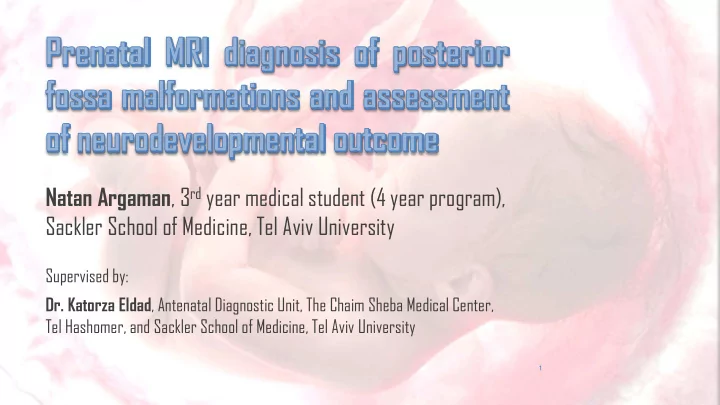

Natan Argaman , 3 rd year medical student (4 year program), Sackler School of Medicine, Tel Aviv University Supervised by: Dr. Katorza Eldad , Antenatal Diagnostic Unit, The Chaim Sheba Medical Center, Tel Hashomer, and Sackler School of Medicine, Tel Aviv University 1
Outline A short reminder What we have done so far Current results Next step 2
3
What was missing in the first step…? R Ber, O Bar-Yosef, C Hoffmann et al. Normal Fetal Posterior Fossa in MR Imaging: 4 New Biometric Data and Possible Clinical Significance. AJNR 2015; 36: 795-802
Aims of the study The current methods of prenatal diagnosis are very limited. Furthermore, the current biometric data is old and maybe lack of updated evidence. Hence, we have 2 objectives to our current research: Validate the curves which Katorza’s group established in the first step Reduce false positive rate of pathological outcomes in prenatal diagnosis 5
Steps of our research Reevaluation of 40 embryos with abnormal findings on MRI in the posterior fossa, using the percentile curves we established last year, comparison to original diagnoses, postnatal diagnoses and neurodevelopmental assessment of the children. 6
7
Step 1. Measurements. A lot of them … We made nearly thousand of measurements - 23 structures in MRI scans of 40 fetuses. In this step we gathered radiological data and defined normal and abnormal fetuses by the current accepted medical curves. 8
9
Midsagittal plane measurements Tentorium Cerebelli 4 th Ventricle Midbrain Torcular Brainstem Pons Medulla oblangata Vermis Cisterna Magna (CM) 10
Axial plane measurments Axial plane Pons 4 th Ventricle Cerebellum Cisterna Magna 11 Vermis
Our data 12
Step 2. Collecting postnatal “ subjective ” neurological development information. We have called 37 mothers in order to collect data about the neurological development of their child. Couple of drawbacks: 1. Only few mothers agreed to fully cooperate. 2. We feel that the test is not reliable enough, though it ’ s a validated telephone questionnaire. 13
Step 3. Collecting postnatal “objective” neurological development information. We have collected medical data of children who came to the pediatric neurological clinic in Sheba Medical Center. Drawback – apparently, only few children were under follow-up of a pediatric neurologist. 14
Case no. 1 (an example) A 41-year-old woman is in her second pregnancy. On routine ultrasound screening test there were suspicious findings. The women referred to fetal MRI scan. 15
MRI findings: 1. Enlarged cisterna magna (22mm) 2. A cystic finding (20x15x25mm), Posterior to the vermis. 16
17
18
19
Out of the initial sample group, only small subgroup underwent a “ subjective ” neurological evaluation (via telephone questionnaire) and even smaller minority has an “ objective ” neurological assessment. Full Initial sample Quality Neurological questionnaire (Total) measurements assessment (Vineland) 44 40 (~91%) 10 (~22%) 5 (~11%) Now what? 20
Step 4. Currently we are establishing different prenatal diagnoses, based on the new biometric data of our group. Special thanks to Roee Ber 21
Step 5. After much thought and consultation, we are now debating whether to try making a more reliable objective assessment to the other children in the initial sample group or to process our current results only. Special thanks to Dr. Omer Bar-Yosef, pediatric neurological clinic 22 and Prof. Reuven Achiron, head of diagnostic ultrasound unit
I want to thank few people for this unique opportunity: Prof. Anat Achiron for leading this great project. Mrs. Yaffit Rot for the great help throughout the year. Dr. Eldad Katorza for the guidance and support! And I will thank you again next year… 23
24
Recommend
More recommend